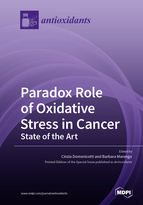Paradox Role of Oxidative Stress in Cancer: State of the Art
A special issue of Antioxidants (ISSN 2076-3921). This special issue belongs to the section "Health Outcomes of Antioxidants and Oxidative Stress".
Deadline for manuscript submissions: closed (31 March 2021) | Viewed by 34947
Special Issue Editors
Interests: neuroblastoma; MYC amplification; cancer stemness; drug resistance; protein kinase C; oxidative stress; lipoperoxidation; apoptosis
Special Issues, Collections and Topics in MDPI journals
Interests: chemoresistance; cancer cell metabolism; stress adaptative cell response; cell death; redox homeostasis; redox signalling; antioxidants; glutathione
Special Issues, Collections and Topics in MDPI journals
Special Issue Information
Dear Colleagues,
Reactive oxygen species (ROS) are produced by healthy cells and are maintained at physiological levels by antioxidant systems such as superoxide dismutases, peroxiredoxins, and glutathione. However, when ROS increase, a condition of oxidative stress occurs with damage to cellular macromolecules, leading to many human diseases, including cancer.
The relationship between oxidative stress and cancer is difficult to understand for many reasons. Firstly, oxidative stress plays an important role during all phases of carcinogenesis, and cancer cells display high ROS levels compared to healthy cells as the consequence of an increased metabolic activity, alterations in electron transport chain of mitochondria, and hypoxic conditions.
Moreover, moderate levels of ROS may have a role as second messengers by activating receptor kinases, MAP kinases, and redox sensitive transcription factors such as NF-kB, AP-1, Nfr2, and HIF-1 and controlling the expression of tumor suppressor genes such as p53. The activation of these signaling molecules can lead to chronic inflammation and an enhanced antioxidant response, promoting cancer cell survival.
Several studies have shown that most chemotherapeutic and radiotherapeutic agents kill cancer cells through ROS production, and long-term anticancer treatment can induce an adaptive antioxidant cell response contributing to the development of chemio/radioresistance. Interestingly, ROS have also been implicated in chemopreventive and chemosensitive action of nutraceuticals derived from natural products. On the basis of these contradictory findings, this Special Issue aims to collect original articles and reviews dealing with the double-edged role of ROS, which can determine beneficial or detrimental outcomes in cancer development. This paradox represents a great challenge for researchers and needs to be investigated in order to light up the molecular mechanisms underlying the dual role of ROS in cancer prevention and therapy.
Prof. Cinzia Domenicotti
Dr. Barbara Marengo
Guest Editors
Manuscript Submission Information
Manuscripts should be submitted online at www.mdpi.com by registering and logging in to this website. Once you are registered, click here to go to the submission form. Manuscripts can be submitted until the deadline. All submissions that pass pre-check are peer-reviewed. Accepted papers will be published continuously in the journal (as soon as accepted) and will be listed together on the special issue website. Research articles, review articles as well as short communications are invited. For planned papers, a title and short abstract (about 100 words) can be sent to the Editorial Office for announcement on this website.
Submitted manuscripts should not have been published previously, nor be under consideration for publication elsewhere (except conference proceedings papers). All manuscripts are thoroughly refereed through a single-blind peer-review process. A guide for authors and other relevant information for submission of manuscripts is available on the Instructions for Authors page. Antioxidants is an international peer-reviewed open access monthly journal published by MDPI.
Please visit the Instructions for Authors page before submitting a manuscript. The Article Processing Charge (APC) for publication in this open access journal is 2900 CHF (Swiss Francs). Submitted papers should be well formatted and use good English. Authors may use MDPI's English editing service prior to publication or during author revisions.
Keywords
- ROS in cancer initiation, promotion, and progression
- ROS and cancer stem cells
- Ferroptosis
- Glutathione and glutathione peroxidase 4
- Redox signaling in cancer
- Nrf2 and related pathways
- Metabolic reprogramming in cancer
- Chemoresistance and radioresistance
- Chemoprevention
- Natural antioxidants








